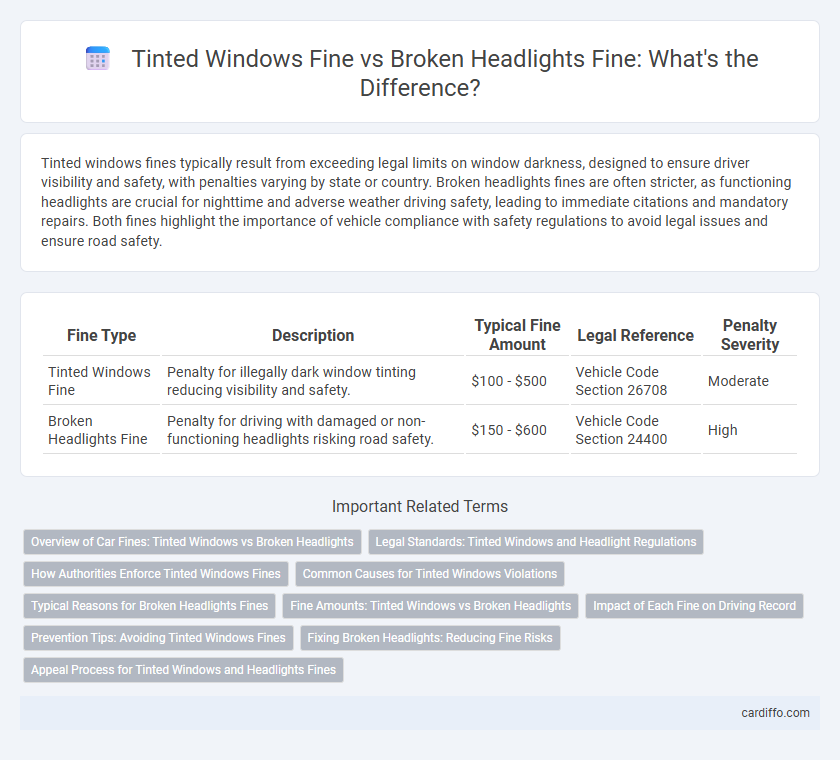Tinted windows fines typically result from exceeding legal limits on window darkness, designed to ensure driver visibility and safety, with penalties varying by state or country. Broken headlights fines are often stricter, as functioning headlights are crucial for nighttime and adverse weather driving safety, leading to immediate citations and mandatory repairs. Both fines highlight the importance of vehicle compliance with safety regulations to avoid legal issues and ensure road safety.
Table of Comparison
| Fine Type | Description | Typical Fine Amount | Legal Reference | Penalty Severity |
|---|---|---|---|---|
| Tinted Windows Fine | Penalty for illegally dark window tinting reducing visibility and safety. | $100 - $500 | Vehicle Code Section 26708 | Moderate |
| Broken Headlights Fine | Penalty for driving with damaged or non-functioning headlights risking road safety. | $150 - $600 | Vehicle Code Section 24400 | High |
Overview of Car Fines: Tinted Windows vs Broken Headlights
Cars with excessively tinted windows often face fines ranging from $50 to $200, depending on state regulations that prioritize driver visibility and safety. Broken headlights fines typically incur penalties between $100 and $300, as they directly affect nighttime driving and increase accident risk. Law enforcement agencies focus on these violations to ensure compliance with safety standards and reduce traffic hazards.
Legal Standards: Tinted Windows and Headlight Regulations
Legal standards for tinted windows vary by state, typically specifying the maximum allowable tint percentage to ensure driver visibility and safety, with stricter regulations often near the windshield and front side windows. Headlight regulations require functioning headlights that meet brightness and alignment criteria to maintain road visibility, with fines imposed for broken or non-compliant headlights. Enforcement of these standards aims to reduce traffic hazards, balancing vehicle customization rights with public safety concerns.
How Authorities Enforce Tinted Windows Fines
Authorities enforce tinted windows fines through regular traffic stops and enhanced patrols targeting vehicle visibility compliance, using specialized light meters to measure permissible tint levels. Violations often result in immediate citations, with officers documenting fines based on state-specific regulations that typically allow less tint on front side windows for safety reasons. Compared to broken headlights fines, enforcement of tinted windows fines involves more technical inspections since tint darkness directly affects driver visibility and law enforcement's ability to observe inside vehicles.
Common Causes for Tinted Windows Violations
Common causes for tinted windows violations include excessive darkness beyond state regulations, use of non-compliant materials, and failure to display necessary stickers or certificates. Law enforcement often issues fines when tinting significantly reduces visibility, impeding driver safety and law enforcement inspection. These violations carry distinct penalties compared to broken headlights fines, which usually arise from damaged or non-functioning lighting impairments.
Typical Reasons for Broken Headlights Fines
Typical reasons for broken headlights fines include cracked or shattered lens covers, non-functioning bulbs, and misaligned headlights that reduce visibility and safety. Law enforcement issues citations because damaged headlights fail to meet vehicle safety standards, increasing accident risks during low-light conditions. Ensuring headlights are fully operational and intact prevents fines and enhances nighttime road safety compliance.
Fine Amounts: Tinted Windows vs Broken Headlights
Fines for tinted windows typically range from $100 to $200 depending on state regulations, while broken headlights result in citations averaging $50 to $150. The severity and enforceability of these fines vary, with tinted windows often facing stricter penalties due to visibility and safety concerns. Enforcement agencies prioritize broken headlights fines lower as they may be corrected immediately, whereas tinted windows infractions often require costly professional removal or replacement.
Impact of Each Fine on Driving Record
A tinted windows fine typically results in minor points or warnings on a driving record, having a less severe impact compared to broken headlights, which often lead to higher fines and more significant record penalties. Broken headlights pose a greater safety risk, thus fines for this violation are more likely to affect insurance rates and driver eligibility. Persistently ignoring either violation can escalate consequences, but broken headlights carry stronger immediate implications for driving privileges.
Prevention Tips: Avoiding Tinted Windows Fines
To avoid tinted windows fines, ensure window tint levels comply with state regulations by checking the allowed Visible Light Transmission (VLT) percentage before installation. Use professional tinting services that adhere to local legal standards and regularly inspect the tint for wear or peeling that might attract law enforcement attention. Keeping replacement or removal options accessible allows quick correction if a tint violation is issued, minimizing potential fines.
Fixing Broken Headlights: Reducing Fine Risks
Fixing broken headlights promptly reduces the risk of incurring fines, which can range from $100 to $200 depending on state regulations. Properly functioning headlights improve vehicle safety and ensure compliance with traffic laws, preventing costly penalties. Regular maintenance and timely repairs are essential to avoid disruptions caused by traffic stops and fines related to lighting violations.
Appeal Process for Tinted Windows and Headlights Fines
The appeal process for tinted windows fines typically involves proving compliance with state tint laws through evidence such as photos or receipts from professional installations. In contrast, appealing broken headlights fines requires demonstrating the timely repair or replacement of the headlights, often supported by repair shop invoices or inspection certificates. Both appeals demand adherence to specific documentation and submission deadlines to increase the likelihood of fine dismissal or reduction.
Tinted Windows Fine vs Broken Headlights Fine Infographic

 cardiffo.com
cardiffo.com